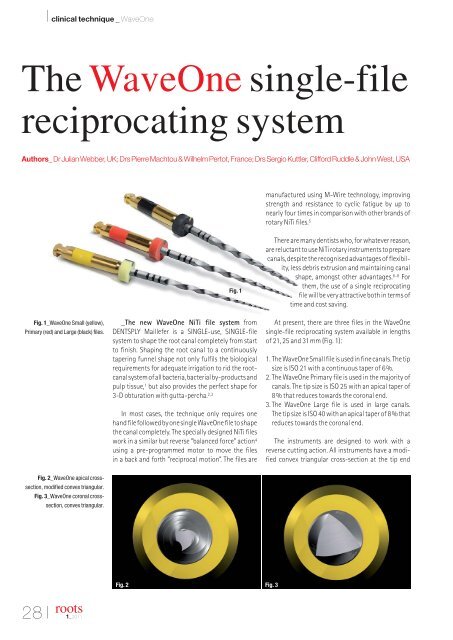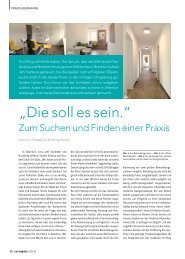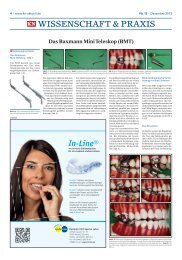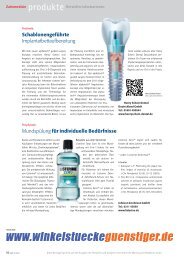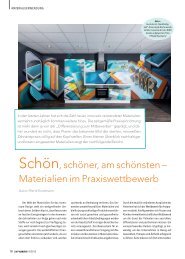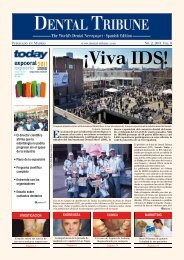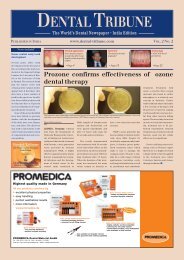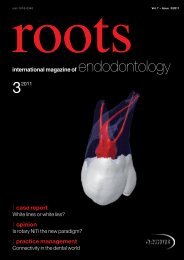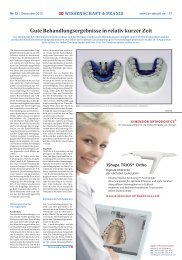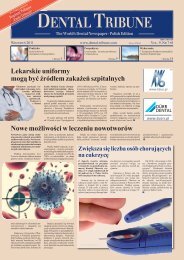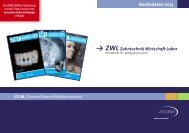RO0111_28-33_Webber (Page 1) - ZWP online
RO0111_28-33_Webber (Page 1) - ZWP online
RO0111_28-33_Webber (Page 1) - ZWP online
Create successful ePaper yourself
Turn your PDF publications into a flip-book with our unique Google optimized e-Paper software.
I clinical technique _ WaveOne<br />
The WaveOne single-file<br />
reciprocating system<br />
Authors_ Dr Julian <strong>Webber</strong>, UK; Drs Pierre Machtou & Wilhelm Pertot, France; Drs Sergio Kuttler, Clifford Ruddle & John West, USA<br />
manufactured using M-Wire technology, improving<br />
strength and resistance to cyclic fatigue by up to<br />
nearly four times in comparison with other brands of<br />
rotary NiTi files. 5<br />
Fig. 1_WaveOne Small (yellow),<br />
Primary (red) and Large (black) files.<br />
Fig. 1<br />
_The new WaveOne NiTi file system from<br />
DENTSPLY Maillefer is a SINGLE-use, SINGLE-file<br />
system to shape the root canal completely from start<br />
to finish. Shaping the root canal to a continuously<br />
tapering funnel shape not only fulfils the biological<br />
requirements for adequate irrigation to rid the rootcanal<br />
system of all bacteria, bacterial by-products and<br />
pulp tissue, 1 but also provides the perfect shape for<br />
3-D obturation with gutta-percha. 2,3<br />
In most cases, the technique only requires one<br />
hand file followed by one single WaveOne file to shape<br />
the canal completely. The specially designed NiTi files<br />
work in a similar but reverse “balanced force” action 4<br />
using a pre-programmed motor to move the files<br />
in a back and forth “reciprocal motion”. The files are<br />
There are many dentists who, for whatever reason,<br />
are reluctant to use NiTi rotary instruments to prepare<br />
canals, despite the recognised advantages of flexibility,<br />
less debris extrusion and maintaining canal<br />
shape, amongst other advantages. 6–8 For<br />
them, the use of a single reciprocating<br />
file will be very attractive both in terms of<br />
time and cost saving.<br />
At present, there are three files in the WaveOne<br />
single-file reciprocating system available in lengths<br />
of 21, 25 and 31mm (Fig. 1):<br />
1. The WaveOne Small file is used in fine canals. The tip<br />
size is ISO 21 with a continuous taper of 6%.<br />
2. The WaveOne Primary file is used in the majority of<br />
canals. The tip size is ISO 25 with an apical taper of<br />
8% that reduces towards the coronal end.<br />
3. The WaveOne Large file is used in large canals.<br />
The tip size is ISO 40 with an apical taper of 8% that<br />
reduces towards the coronal end.<br />
The instruments are designed to work with a<br />
reverse cutting action. All instruments have a modified<br />
convex triangular cross-section at the tip end<br />
Fig. 2_WaveOne apical crosssection,<br />
modified convex triangular.<br />
Fig. 3_WaveOne coronal crosssection,<br />
convex triangular.<br />
Fig. 2 Fig. 3<br />
<strong>28</strong> I<br />
roots<br />
1_2011
clinical technique _ WaveOne I<br />
reciprocating cycles complete one complete reverse<br />
rotation and the instrument gradually advances into<br />
the canal with little apical pressure required.<br />
Fig. 4_WaveOne variable pitch flute<br />
increases safety.<br />
Fig. 4<br />
(Fig. 2) and a convex triangular cross-section at the<br />
coronal end (Fig. 3). This design improves instrument<br />
flexibility overall. The tips are modified to follow canal<br />
curvature accurately. The variable pitch flutes along<br />
the length of the instrument considerably improve<br />
safety (Fig. 4).<br />
Because there is a possibility of cross-contamination<br />
associated with the inability to completely clean<br />
and sterilise endodontic instruments 9 and the possible<br />
presence of prion in human dental pulp tissue, 10 all<br />
instruments used inside root canals should be single<br />
use. 11 WaveOne instruments are a new concept in this<br />
important standard of care, as they are truly single<br />
use. The plastic colour coding in the handle becomes<br />
deformed once sterilised, preventing the file from<br />
being placed back into the handpiece.<br />
The recommendation for single use has the added<br />
advantage of reducing instrument fatigue, which is<br />
an even more important consideration with WaveOne<br />
files, as one file does the work traditionally performed<br />
by three or more rotary NiTi files.<br />
The WaveOne motor (Fig. 5) is rechargeable battery<br />
operated with a 6:1 reducing handpiece. The pre-pro -<br />
grammed motor is set for the angles of reciprocation<br />
and speed for WaveOne instruments. The counterclockwise<br />
(CCW) movement is greater than the clockwise<br />
(CW) movement. CCW movement advances<br />
the instrument, engaging and cutting the dentine.<br />
CW movement disengages the instrument from the<br />
dentine before it can (taper) lock into the canal. Three<br />
All brands of NiTi files can be used with the<br />
WaveOne motor, as it has additional functions for<br />
continuous rotation. However, as WaveOne files<br />
have their own unique reverse design, they can ONLY<br />
be used with the WaveOne motor with its reverse<br />
reciprocating function.<br />
The WaveOne technique involves<br />
the following stages:<br />
1. straightline access, accepted<br />
protocol;<br />
2. WaveOne file selection;<br />
3. single-file shaping;<br />
4. copious irrigation with 5% NaOCl<br />
and EDTA before, during and after<br />
single-file shaping.<br />
_WaveOne file selection and clinical<br />
procedure (Figs. 6–8)<br />
Fig. 5<br />
Whilst a good preoperative periapical radiograph<br />
will give an indication of what to expect before<br />
the canal is prepared (size and length of the canal,<br />
number of canals, degree and severity of curvature),<br />
Fig. 5_WaveOne motor and 6:1<br />
reducing handpiece.<br />
Figs. 6–8_WaveOne Small, Primary<br />
and Large files with their respective<br />
file selection and clinical procedural<br />
flow chart.<br />
Fig. 6 Fig. 7 Fig. 8<br />
roots<br />
1_2011<br />
I29
I clinical technique _ WaveOne<br />
Fig. 9<br />
Fig. 13<br />
Fig. 9_EndoActivator irrigation device.<br />
Fig. 13_Calamus Dual 3-D<br />
Obturation System.<br />
Fig. 10_WaveOne matching<br />
paper points.<br />
Fig. 11_WaveOne matching<br />
gutta-percha points.<br />
Fig. 12_WaveOne matching<br />
Thermafil obturators.<br />
only the first hand file into the canal will aid in the<br />
selection of the WaveOne file as follows:<br />
1. If a 10 K-file is very resistant to movement, use<br />
WaveOne Small file.<br />
2. If a 10 K-file moves to length easily, is loose or very<br />
loose, use WaveOne Primary file.<br />
3. If a 20 hand file or larger goes to length, use<br />
WaveOne Large file.<br />
Single-file shaping<br />
1. take hand file into canal and watch-wind to length<br />
or resistance (approximately two-thirds of canal<br />
length);<br />
2. use appropriate WaveOne file to approximately<br />
two-thirds of canal length;<br />
3. irrigate copiously;<br />
4. take hand file to length and confirm with an apex<br />
locator and radiograph;<br />
5. take WaveOne file to length;<br />
Fig. 10<br />
Fig. 11<br />
Fig. 12<br />
6. confirm foramen diameter with hand file the same<br />
size as WaveOne file; if snug, preparation is complete;<br />
7. if foramen diameter is larger than WaveOne file,<br />
consider the next larger WaveOne file;<br />
8. majority of cases will be completed with WaveOne<br />
Primary file.<br />
Guidelines for use<br />
1. use WaveOne files with a progressive up and down<br />
movement no more than three to four times, only<br />
little force is required;<br />
2. remove file regularly, wipe clean, irrigate and continue;<br />
3. if file does not progress, confirm patent canal and<br />
consider using a smaller WaveOne file;<br />
4. whilst glide path management is minimal with<br />
WaveOne shaping files, some practitioners will be<br />
more comfortable if the glide path is first secured<br />
with PathFiles (DENTSPLY Maillefer);<br />
5. in severely curved canals, complete apical pre -<br />
paration by hand if reproducible glide path is not<br />
possible;<br />
6. WaveOne files can be used to relocate the canal<br />
orifice and expand coronal shape; even in a reciprocating<br />
motion use them with a “brushing” action<br />
short of length to achieve this;<br />
7. never work in a dry canal and constantly irrigate<br />
with NaOCl and later EDTA;<br />
8. as preparation time is short, activate the irrigating<br />
solutions to enhance their effect; the EndoActivator<br />
(DENTSPLY Maillefer) is ideal for this (Fig. 9). 12<br />
WaveOne obturating solutions<br />
Obturation of the root-canal system is the final<br />
step of the endodontic procedure. The WaveOne<br />
system includes matching paper points, guttapercha<br />
points and Thermafil WaveOne obturators<br />
(Figs. 10–12). The matching gutta-percha points<br />
can be used in conjunction with the Calamus Dual<br />
3-D Obturation System (DENTSPLY Maillefer; Fig. 13)<br />
as demonstrated in the following cases.<br />
30 I<br />
roots<br />
1_2011
clinical technique _ WaveOne I<br />
Figs. 14a–c_Pre-op radiograph of<br />
#36 showing narrow and curved<br />
canals (a). Post-op radiographs:<br />
Canals were shaped with a WaveOne<br />
Primary file and filled with<br />
gutta-percha with WVC (b & c).<br />
Fig. 14a Fig. 14b Fig. 14c<br />
Figs. 15a–c_Pre-op radiograph of<br />
#16 showing severely curved MB and<br />
DB canals (a). Post-op radiographs:<br />
Canals were shaped with a WaveOne<br />
Primary file and filled with<br />
gutta-percha with WVC (b & c).<br />
Fig. 15a Fig. 15b Fig. 15c<br />
_Case studies<br />
Case I (Figs. 14a–c)<br />
Tooth #36 presented with symptoms of irreversible<br />
pulpitis and early apical periodontitis. Initial<br />
radio graphic assessment showed four narrow and<br />
curved canals. Access was made and all canals were<br />
worked to length with a 10 K-file. A WaveOne Primary<br />
file (25.08) was selected and length was reconfirmed<br />
with a 10 K-file. The WaveOne Primary file was worked<br />
to length in all four canals. Obturation was done with<br />
warm vertical condensation (WVC) using Calamus<br />
Dual.<br />
Case II (Figs. 15a–c)<br />
Tooth #16 had symptoms of acute pulpitis with a<br />
temporary filling, covering exposure distally, as well<br />
as severe curvature of the mesiobuccal (MB) canals<br />
and apically in the distal canal. K-files 8 and 10 were<br />
taken to length in all the canals. A WaveOne Primary<br />
file (25.08) was selected. Length was confirmed with<br />
a 10 K-file. The WaveOne Primary file was taken to<br />
length in all the canals. Obturation was done with<br />
WVC using Calamus Dual.<br />
Case III (Figs. 16a–c)<br />
Tooth #17 presented with radiographic evidence<br />
of apical periodontitis and was non-vital. The canals<br />
were hardly visible on the preoperative X-ray. Primary<br />
consideration would have been a WaveOne Small file<br />
(21.06). In all canals, the 8 K-file moved to length<br />
easily. The 10 K-file also moved to length but was<br />
tight.<br />
A WaveOne Primary file (25.08) was selected and<br />
taken to approximately three-quarters of the length.<br />
Recapitulation was achieved with a 10K-file to length.<br />
The WaveOne Primary was taken to length in all the<br />
canals and the canals were then obturated with WVC.<br />
Figs. 16a–c_Pre-op radiograph of<br />
#17 with canals hardly visible (a).<br />
Post-op radiographs: Canals were<br />
shaped with a WaveOne Primary file<br />
and filled with gutta-percha with WVC<br />
(b & c).<br />
Fig. 16a<br />
Fig. 17a<br />
Fig. 16b<br />
Fig. 17b<br />
Fig. 16c<br />
Fig. 17c<br />
Figs. 17a–c_Pre-op radiograph of<br />
#17 with canals barely visible and<br />
#15 with a quite large canal (a).<br />
Post-op radiographs: #17 canals<br />
were shaped with a WaveOne Primary<br />
file. #15 canal was shaped with a<br />
WaveOne Large file. All canals were<br />
filled with gutta-percha with WVC<br />
(b & c).<br />
roots<br />
1_2011<br />
I31
I clinical technique _ WaveOne<br />
Fig. 18a Fig. 18b Fig. 18c<br />
Fig. 19a Fig. 19b Fig. 19c<br />
Figs. 18a–c_Micro-focus CT scan at<br />
coronal level (a), mid-root level (b)<br />
and apical level (c) of the<br />
mesial canals of the lower first molar<br />
demonstrates the excellent centring<br />
and shaping ability of the WaveOne<br />
Primary file.<br />
Figs. 19a–c_A SEM representative<br />
sample at coronal level (a), mid-root<br />
level (b) and apical level (c) of the<br />
canal wall, showing excellent<br />
cleanliness and open dentinal<br />
tubules after shaping with<br />
a WaveOne Primary file and assisted<br />
irrigation with the EndoActivator.<br />
Case IV (Figs. 17a–c)<br />
Tooth #16 presented with radiographic evidence<br />
of asymptomatic apical periodontitis. The canals were<br />
hardly visible on the preoperative X-ray. The MB canal<br />
was severely curved, and the distobuccal (DB) and<br />
palatal canals were not visible. A 10 K-file moved to<br />
length easily in the MB and DB canals. In the palatal<br />
canal, 10 and 15 K-files moved to length easily. A<br />
WaveOne Primary file (25.08) was selected for all<br />
canals. Lengths were confirmed and the canals were<br />
shaped to length with WaveOne files.<br />
In tooth #15, a large, single canal was clearly visible.<br />
20 and 25 K-files went to length and a WaveOne<br />
Large file (40.08) was selected. Canal length was confirmed<br />
and the WaveOne Large file was used to shape<br />
the canal.<br />
_Advantages of the WaveOne file<br />
reciprocating system<br />
1. only one NiTi instrument per root canal and in most<br />
cases per tooth;<br />
2. lower cost;<br />
3. less instrument separation owing to the unique<br />
reciprocating movement that will prevent and/or<br />
delay the instrument advancing from plastic deformation<br />
to its plastic limit;<br />
4. decreases global shaping time, allowing the clinician<br />
to spend more time cleaning the root-canal<br />
system with enhanced irrigation techniques;<br />
5. eliminates procedural errors by using a single<br />
instrument rather than using multiple files;<br />
6. a new standard of care, eliminating the possibility<br />
of prion contamination owing to single use;<br />
7. easy to learn;<br />
8. easy to teach.<br />
_WaveOne research<br />
The Nova Southeastern University College of Dental<br />
Medicine in the USA is conducting research into<br />
WaveOne. The following areas of research, amongst<br />
others, are being investigated using micro-focus CT<br />
scanning technology, which provides remarkable insight<br />
into:<br />
1. canal-centring ability of WaveOne 13 (Figs. 18a–c);<br />
2. remaining canal wall thickness after instrumentation<br />
with WaveOne; 14<br />
3. final shape versus initial shape of the canal with<br />
WaveOne; 15<br />
4. canal wall cleanliness with WaveOne 16 (Figs. 19a–c).<br />
Other areas of research are flexibility, 17 fatigue 18<br />
and debris extrusion. 19 To date, the results of these<br />
studies suggest that WaveOne single reciprocating<br />
files are comparable in performance to all the major<br />
leading brands of NiTi files that operate in continuous<br />
rotation.<br />
_Conclusion<br />
The WaveOne system is an exciting new concept in<br />
the preparation of the root canal. Whilst current<br />
teaching advocates the use of multiple NiTi files of<br />
different diameter and taper to gradually enlarge<br />
the root canal, only one WaveOne single shaping file<br />
is required to prepare the canal to an adequate size<br />
and taper, even in narrow and curved canals.<br />
However, along with this, there must be a caveat.<br />
WaveOne files only shape the canal, extremely quickly<br />
in many instances, but they do not clean the root<br />
canal. It is the duty of teachers, clinicians and manufacturers<br />
to emphasise the role and importance of<br />
32 I<br />
roots<br />
1_2011
clinical technique _ WaveOne I<br />
irrigation as a major determinant of endodontic<br />
success. Once it is fully appreciated that shaping<br />
and cleaning the root-canal system are irrevocably<br />
intertwined, then endodontics will be easier for all<br />
and available to all, and WaveOne will truly become<br />
the root-canal preparation instrument of the future.<br />
Drs Julian <strong>Webber</strong>, Pierre Machtou, Wilhem Pertot,<br />
Sergio Kuttler, Clifford Ruddle and John West where<br />
involved in the development, field testing and research<br />
associated with WaveOne._<br />
_References<br />
1. Sjogren U, Figdor D, Persson S, Sundqvist G. Influence of infection<br />
at the time of root filling on the outcome of endodontic<br />
treatment of teeth with apical periodontitis. Int Endod J<br />
1997; 30(5): 297–306.<br />
2. Schilder H. Cleaning and shaping the root canal. Dent Clin<br />
Amer 1974; 18(2): 269–96.<br />
3. West JD. Endodontic predictability—“Restore or remove:<br />
how do I choose?” In: Cohen M, ed. Interdisciplinary Treatment<br />
Planning: Principles, Design, Implementation. Quintessence<br />
Publishing Co., 2008:123–64.<br />
4. Roane JB, Sabala CL, Duncanson MG. The “balanced force”<br />
concept for instrumentation of curved canals. J. Endod<br />
1985; 11(5): 203–11.<br />
5. Johnson E, Lloyd A, Kuttler S, Namerow K. Comparison between<br />
a novel nickel titanium alloy and 508 Nitinol on the<br />
cyclic fatigue life of Profile 25/.04 rotary instruments. J Endod<br />
2008; 34(11): 1406–9.<br />
6. Walia HM, Brantley WA, Gerstein H. An initial investigation on<br />
the bending and torsional properties of Nitinol root canal<br />
files. J Endod 1998; 14(7): 340–51.<br />
7. Reddy SA, Hicks ML. Apical extrusion of debris using two<br />
hand and two rotary instrumentation techniques. J Endod<br />
1998; 249(3): 180–3.<br />
8. Pettiette MT, Delano EO, Trope M. Evaluation of success rate<br />
of endodontic treatment performed by students with stainless<br />
steel K files and nickel titanium hand files. J Endod<br />
2001; 27(2): 124–7.<br />
9. Letters S et al. A study of visual and blood contamination on<br />
reprocessed endodontic files from general dental practice.<br />
Brit Dent J 2005; 199: 522–5.<br />
10. Schneider K, Korkmaz Y, Addicks K, Lang H et al. Prion Protein<br />
(PrP) in human teeth: an unprecedented pointer to PrP’s<br />
function. J Endod 2007; <strong>33</strong>(2): 110–3.<br />
11. Department of Health (UK). Advice for dentists on the re-use<br />
of endodontic instruments and variant Creutzfeldt-Jacob<br />
Disease (vCJD). April 2007.<br />
12. Ruddle CJ. Endodontic disinfection: tsunami irrigation. Endo<br />
Prac. 2008;11:7–16.<br />
13. Kuttler S, Bonilla C, Perez R, Hardigan P. Evaluation of remaining<br />
canal wall thickness and center ability after instrumentation<br />
with a new reciprocating system. 2011a. In<br />
press.<br />
14. <strong>Webber</strong> J, Kuttler S, Bonilla C, Perez R, Hardigan P. Evaluation<br />
of remaining canal wall thickness and center ability after<br />
instrumentation with WaveOne reciprocating system vs<br />
rotary BioRace NiTi system. 2011b. In press.<br />
15. Pertot W, Machtou M, Kuttler S, Bonilla C, Perez, R, Hardigan<br />
P. Evaluation of remaining canal wall thickness and center<br />
ability after instrumentation with WaveOne reciprocating<br />
system vs Revo-S rotary NiTi system. 2011. In press.<br />
16. Machtou P, Kuttler S, Bonilla C, Pertot W, Perez R, Hardigan<br />
P. Evaluation of canal wall cleanliness after instrumentation<br />
with four nickel titanium rotary file systems and one reciprocating<br />
system. 2011. In press.<br />
17. McLean R, Kuttler S et al. Evaluation of the flexibility of 4<br />
nickel titanium rotary file systems and one reciprocating file<br />
system. 2011. In press.<br />
18. Coil J, Shen Y, Kuttler S, Bonilla C, Ruddle C, West J, Rigoberto<br />
P, Hardigan P. 2011. In press.<br />
19. Armando L, Kuttler S, Bonilla C, <strong>Webber</strong> J, Machtou P, Pertot<br />
W, Perez R, Hardigan P. Comparison of the extruded debris<br />
of a new nickel titanium reciprocating file versus four<br />
conventional rotary systems. Jan 2011. In press.<br />
_about the lead author<br />
Dr Julian <strong>Webber</strong> has<br />
been a practising endodontist<br />
in London, England, for<br />
over 30 years. He was the<br />
first UK dentist to receive a<br />
Master’s degree in Endo -<br />
dontics from a university<br />
in the USA (Northwestern<br />
University Dental School,<br />
Chicago) in 1978. He has lectured extensively and<br />
given many hands-on courses on endodontics<br />
worldwide. He has written in numerous peerreviewed<br />
journals and contributed numerous<br />
chapters in endodontic texts. Dr <strong>Webber</strong> is a former<br />
President of the British Endodontic Society, a faculty<br />
member of the Pacific Endodontic Research<br />
Foundation in San Diego, Honorary Professor at the<br />
University of Belgrade, Serbia, and an Honorary<br />
Member of the Ukrainian Medical and Stomatological<br />
Academy. He is a fellow of the International<br />
College of Dentists and an active member of the<br />
American Association of Endodontists. He is the<br />
editor of Endodontic Practice (UK) and a board<br />
member of many prestigious dental journals.<br />
Dr Julian <strong>Webber</strong><br />
The Harley Street Centre for Endodontics<br />
121 Harley Street<br />
London W1G 6AX<br />
England<br />
jw@julianwebber.com<br />
www.roottreatmentuk.com<br />
roots<br />
roots<br />
1_2011<br />
I<strong>33</strong>


